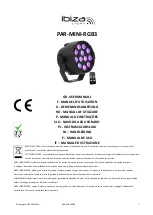
M9B-HFS OPERATION
M9B-HFS INTERFACE
3-10
Release 1.0 (97/10)
REN <state>
Parameters:
<0/OFF,1/ON>
Remote Enable. With the REN 0, the power supply is in local mode. If a command is sent
from the computer, the power supply does not respond but remains in local mode. With
REN 1, the power supply will enter remote mode when a command is sent from the
computer.
REN?
Asks for the state of remote enable.
Response:
REN <state>
ROM?
Asks for the version number of the master and slave EPROMs located on the interface
PCB.
Response:
ROM M:<version> S:<version>
RST
Resets the supply to present voltage and current settings if the output is disabled by
over voltage or foldback protection. Output values changed via software commands while
the unit is disabled will not take effect until RST is used.
STS?
Asks for the supply’s present status register. Status conditions are stored in the status
register. Each bit represents a separate condition. When the condition is true, the
corresponding bit is 1. Bits remain set in the status register as long as the condition is
true. See
Section 3.4 Accumulated Status, Status, and Fault Registers.
Response:
STS <status mask>
where status mask is the decimal equivalent of the total bit weights for the operating
conditions as listed in the status register.
TRG
Implements programmed voltage and current settings which had been in hold mode. The
supply operates with previous values until the TRG (trigger) command is sent.
UNMASK
<mnemonics>
Parameters:
CV, CC, OV, SD, FOLD, ERR, OT, ACF, OPF,SNSP
,
ALL, NONE
Enables you to select the supply operating conditions that you are most interested in
monitoring for fault occurrence. Mnemonics describing the conditions are separated from
each other by commas, and may be sent in any order. Specifying one or more mnemonics
which describe the conditions (or the decimal equivalent of their total bit weight) enables
the selected conditions to set bits in the supply’s fault and status registers during
operation. A bit is set in the fault register when the corresponding bit in the status
register changes from 0 to 1 and the corresponding bit in the mask register is 1. See
Section 3.4
Accumulated Status, Status, and Fault Registers
.
Initial value:
UNMASK NONE
Note:
UNMASK NONE = MASK ALL; MASK NONE = UNMASK ALL
UNMASK?
Asks for the supply's fault conditions which are currently enabled (unmasked).
Response:
UNMASK <fault mask>
where fault mask is the decimal equivalent of the total bit weights for the operating
conditions as listed in the status and fault registers See Section 3.4 Accumulated Status,
Status, and Fault Registers
.
















































